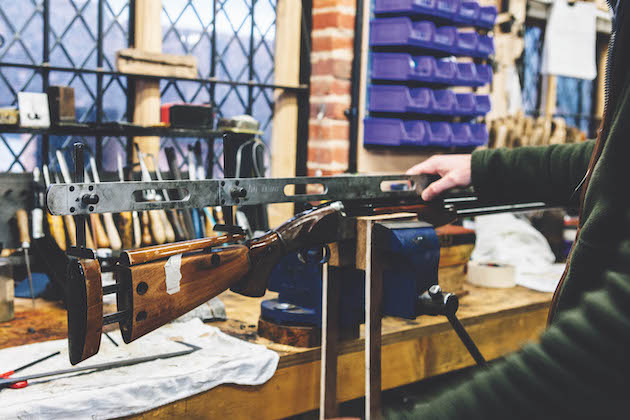Mark Heath, Instructor Manager at West London Shooting School, offers some tips for newcomers
Do these common mistakes sound familiar?
1. Poor stance
For a novice their instinct is to address where the target is coming from rather than having the body in a comfortable position where they intend to break the target / kill the bird. For a clay shooting they can address the break point before they call for the target, a game shooter needs to be taught good footwork. Bad footwork looks like strictly come dancing gone wrong.
2. Poor posture
Weight on the back foot for most shooting is unhelpful and leads to head lifting and consequently, stopping the gun as the trigger is pulled, weight just over the front foot (nose over toes) is the best stance for most shooters especially in relation to driven game.

Bad footwork leads to a lack of stability and balance, which means you are likely to miss
3. It’s not an aiming sport!
Most novices when handed a shotgun especially if it’s got a nice big coloured bead on the end, will naturally want to aim it with the consequence that the gun will almost certainly stop when they pull the trigger. Focus needs to be hard on the target, never underestimate how hard you have to concentrate to shoot well. 98% concentration just doesn’t cut it.

A woman Gun having some lessons at the West London Shooting School
4. Don’t rush out and buy a gun
Just because your mate has an XYZ gun and loves it to bits doesn’t mean it’s suitable for you. If you can try all the different main brands and get advice from different quarters, sorry if I offend anyone but an experienced instructor who is teaching on a regular basis is probably a better bet for un-biased advice on the right gun for you based on experience than the salesman. (Read our gun buying guide here.)
(Mark Heath regularly reviews guns for Shooting Times and you can read his articles here.)
5. Don’t always listen to advice coming from behind the stand
Well intentioned advice from friends standing behind you such as swing faster, your behind it or you missed the line are well intentioned, but probably inaccurate. They make mistakes too. Time and money spent with an experienced instructor are investments and you should see the improvements and enjoy your sport more as a consequence. Stance, mount, timing, line and lead are all skills that can invariably be taught in time, not picked up casually.

Gun fit is important, so make sure you consult a professional
6. Gun fitting
Shooting a gun that fits you makes a significant difference in comfort and consistency in your shooting. This is especially so for ladies, where not all are most suited to guns that are marketed towards them. Many female shooters would be better off with a standard gun off the shelf adjusted to their measurements after a fitting with a try gun. A proper fitting will measure length, drop and cast not just a guess at the length after a few dry mounts. (Read more on how a woman went about buying her first gun.)
7. Speed and aggression
Many try and improve their shooting by aggressive styles which is often presented to me by clients as instinctive shooting. Timing is critical to consistent shooting, swing and hope will let you hit a few targets, but consistency will never be a key theme of your shooting.
8. Read the target / bird
For a clay shooter, clever course setters will mislead shooters into thinking the clay is doing something it is not. Time spent watching the clay carefully rather than the previous shooter is seldom wasted. Game shooters the same philosophy applies, many misread the speed and line of the bird especially partridge where they overestimate the speed of the bird. If you get a chance look down the line of shooters at the birds overhead, you will often see that they are higher than you think when you see them coming over your peg. Clay shooters do the same especially on tower birds.
9. Master eye issues
We teach thousands of people each year at West London Shooting School and as a consequence, problem solving shooting issues becomes second nature because we practise it every working day. Not everyone can shoot with both eyes open, but you can shoot just as well as anybody else where the closing of an eye is necessary. Experienced instructors will pick this up very quickly at the start of your lesson, self-diagnosis is not always accurate. Take advice from a professional so that you can be sure you are doing the right thing.
10. Don’t let your shooting go downhill and do nothing about it
If your shooting starts to rapidly deteriorate don’t just think you can retrieve it. Go and see an experienced instructor, if they are teaching regularly, they will diagnose the problem and get you back on track. It may just be a loss of confidence caused by forgetting certain elements of your shooting, these can be re-built by helping you with your shooting methods to get you back on track.




